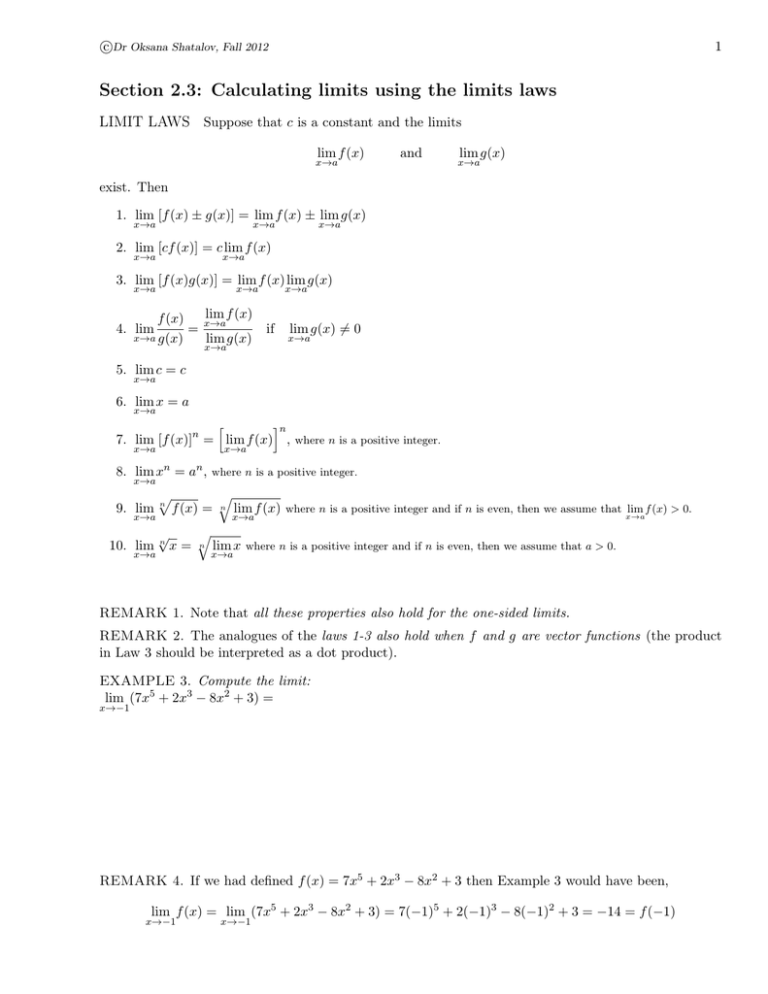Document 10581532
advertisement

c Dr Oksana Shatalov, Fall 2012 1 Section 2.3: Calculating limits using the limits laws LIMIT LAWS Suppose that c is a constant and the limits lim f (x) x→a and lim g(x) x→a exist. Then 1. lim [f (x) ± g(x)] = lim f (x) ± lim g(x) x→a x→a x→a 2. lim [cf (x)] = c lim f (x) x→a x→a 3. lim [f (x)g(x)] = lim f (x) lim g(x) x→a x→a lim f (x) f (x) x→a = x→a g(x) lim g(x) 4. lim x→a if lim g(x) 6= 0 x→a x→a 5. lim c = c x→a 6. lim x = a x→a h in 7. lim [f (x)]n = lim f (x) , where n is a positive integer. x→a x→a n n 8. lim x = a , where n is a positive integer. x→a 9. lim x→a 10. lim x→a q p n f (x) = n lim f (x) where n is a positive integer and if n is even, then we assume that x→a lim f (x) > 0. x→a √ n x= q n lim x where n is a positive integer and if n is even, then we assume that a > 0. x→a REMARK 1. Note that all these properties also hold for the one-sided limits. REMARK 2. The analogues of the laws 1-3 also hold when f and g are vector functions (the product in Law 3 should be interpreted as a dot product). EXAMPLE 3. Compute the limit: lim (7x5 + 2x3 − 8x2 + 3) = x→−1 REMARK 4. If we had defined f (x) = 7x5 + 2x3 − 8x2 + 3 then Example 3 would have been, lim f (x) = lim (7x5 + 2x3 − 8x2 + 3) = 7(−1)5 + 2(−1)3 − 8(−1)2 + 3 = −14 = f (−1) x→−1 x→−1 c Dr Oksana Shatalov, Fall 2012 2 EXAMPLE 5. Compute the limit: x2 + x + 1 lim = x→−2 x3 − 10 REMARK 6. The function from Example 5 also satisfies ”direct substitution property”: lim f (x) = f (a). x→a Later we will say that such functions are continuous. Note that in both examples it was important that a in the domain of f . EXAMPLE 7. Compute the limit: x−3 lim 2 x→3 x − 9 EXAMPLE 8. Compute the limit: x−1 lim 2 x→1 x − 4x + 3 EXAMPLE 9. Given g(x) = Compute the limits: (a) lim g(x) x→4 (b) lim g(x) x→−1 x2 + 4, if x ≤ −1 2 − 3x if x > −1 c Dr Oksana Shatalov, Fall 2012 EXAMPLE 10. Evaluate these limits. x−1 − 0.25 x→4 x−4 (a) lim (x + 5)2 − 25 x→0 x (b) lim |x + 1| x→−1 x + 1 (c) lim x2 + x x→−1 |x + 1| (d) lim (e) lim x→0− 1 1 − x |x| 3 c Dr Oksana Shatalov, Fall 2012 √ (f ) lim x→0 6−x− x √ 4 6 Conclusion from the above examples: To calculate the limit of f (x) as x → a: PLUG IN x = a if a is in the domain of f . Otherwise "FACTOR" or "MULTIPLY BY CONJUGATE" and then plug in. Consider one sided limits if necessary. Squeeze Theorem. Suppose that for all x in an interval containing a (except possibly at x = a) g(x) ≤ f (x) ≤ h(x) and lim g(x) = L = lim h(x). Then x→a x→a lim f (x) = L. x→a Corollary. Suppose that for all x in an interval containing a (except possibly at x = a) |f (x)| ≤ h(x) (equivalently, −h(x) ≤ f (x) ≤ h(x)) and lim h(x) = 0. Then x→a lim f (x) = 0. x→a EXAMPLE 11. Given 3x ≤ f (x) ≤ x3 + 2 for 0 ≤ x ≤ 2. Find lim f (x) x→1 c Dr Oksana Shatalov, Fall 2012 5 EXAMPLE 12. Evaluate: (a) lim x sin x→0 1 x (b) lim(t5 ) cos3 ( t→0 1 ) t2 EXAMPLE 13. Is there a number c such that 3x2 + cx + c + 3 x→−2 x2 + x − 2 lim exists? If so, find the value c and the value of the limit.





